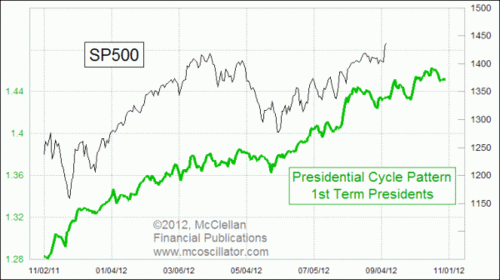Presidential Cycles and the Dow Jones Does it Follow a Predictable Pattern Business Insider
Post on: 29 Апрель, 2015 No Comment

Recent Posts
(Article by Andrew Dominguez; List compiled by Eben Esterhuizen, CFA )
For generations, curious stock market researchers have sought to make sense of the aggregated behavior of innumerable investors. Is there any rhyme or reason behind anything that occurs in the markets or in life?
That latter question is ultimately unknowable. But mankind has math, computers, lots of data, and a knack for seeing patterns in and between disparate events for the former.
As a result, researchers have found numerous ways of predicting the stock markets, from pure technical analysis of movements to the testosterone levels of traders.
One theory that seemingly comes out of left field is the Presidential Election Cycle Theory. Here is a brief run through of some of the evidence proffered by two recent studies.
Mark Hulbert of MarketWatch compiled Dow Jones data dating back to 1896 and found the following:
- the third year of a presidential cycle significantly outperforms all others, with average stock market gains of 15.5% compared to 8.8% in the first year, 0.4% in the second, and 4.1% in the fourth year; his years begin at the end of September because data is quarterly and elections occur in November
- the market performance in the third year of a presidential cycle is not statistically correlated to the market performance of the previous year; in other words, third years have tended to outperform other years regardless of whether the second year in the cycle experienced a boom or a bust
- he also found that there is no significant correlation between stock valuations and market performances in the third year; “On average, third years perform just as well when price/earnings ratios are high as they do when those ratios are low”
Marshall Nickles of Pepperdine University found similar results in his 2004 study.
- historical stock market cycles dating back to 1942 have lasted an average of 4.02 years, which is essentially the same length as a presidential term; a cycle is defined as the time between peaks or the time it takes to go from a peak to a trough and then back to a peak
- stock markets bottomed out only once during the third year of a presidential cycle in data dating back to the FDR administration. The one time the trough occurred in the third year was in December 1987 (Reagan). The average timeframe for a market trough was 1.87 years into the presidential term. Markets never bottomed out in the fourth year.
But why the third year? And why does it have a 94% probability of finishing higher, as Jonathan Burton of MarketWatch asserts?
Nickles attributes this phenomenon to the well-known link between the state of the economy and the results of an election. “It’s the economy stupid!”
In general, incumbent politicians are more likely to be re-elected and their party remains in power if the economy has been doing well. Basically, satisfied voters have tended to re-elect incumbents.
Knowing this, politicians have tended to (or at the very least they are expected to) use fiscal policy to buoy the economy during the campaign season.
Interested in gauging if this theory holds any water? We crunched the numbers, and identified the top 10 performing Dow Jones Average stocks. Are these stocks benefiting from the presidential cycle trend, or are other forces at work?
Use this list as a starting point for your own analysis.
Analyze These Ideas (Tools Will Open In A New Window)

1. Caterpillar Inc. (CAT ): Farm & Construction Machinery Industry. Wall Street analysts expect the company’s earnings to grow by 21.2% over the next 5 years. The stock has gained 54.54% over the last year.
2. Chevron Corp. (CVX ): Major Integrated Oil & Gas Industry. Wall Street analysts expect the company’s earnings to grow by 5.47% over the next 5 years. The stock has gained 53.2% over the last year.
3. EI DuPont de Nemours & Co. (DD ): Chemicals Industry. Wall Street analysts expect the company’s earnings to grow by 9.38% over the next 5 years. The stock has gained 47.92% over the last year.
4. International Business Machines Corp. (IBM ): Diversified Computer Systems Industry. Wall Street analysts expect the company’s earnings to grow by 10.83% over the next 5 years. The stock has gained 46.83% over the last year.
5. Exxon Mobil Corporation (XOM ): Major Integrated Oil & Gas Industry. Wall Street analysts expect the company’s earnings to grow by 8.48% over the next 5 years. The stock has gained 46.2% over the last year.
6. Alcoa. Inc. (AA ): Aluminum Industry. Wall Street analysts expect the company’s earnings to grow by 70.43% over the next 5 years. The stock has gained 44.43% over the last year.
7. Pfizer Inc. (PFE ): Drug Manufacturer. Wall Street analysts expect the company’s earnings to grow by 2.92% over the next 5 years. The stock has gained 43.46% over the last year.
8. Verizon Communications Inc. (VZ ): Telecom Services. Wall Street analysts expect the company’s earnings to grow by 6.1% over the next 5 years. The stock has gained 38.33% over the last year.
9. The Home Depot. Inc. (HD ): Home Improvement Stores Industry. Wall Street analysts expect the company’s earnings to grow by 12.77% over the next 5 years. The stock has gained 33.28% over the last year.
10. The Coca-Cola Company (KO ): Beverages Industry. Wall Street analysts expect the company’s earnings to grow by 8.93% over the next 5 years. The stock has gained 31.1% over the last year.
Interactive Chart: Press Play to see how analyst ratings have changed for the stocks mentioned above. Analyst ratings sourced from Zacks Investment Research.














